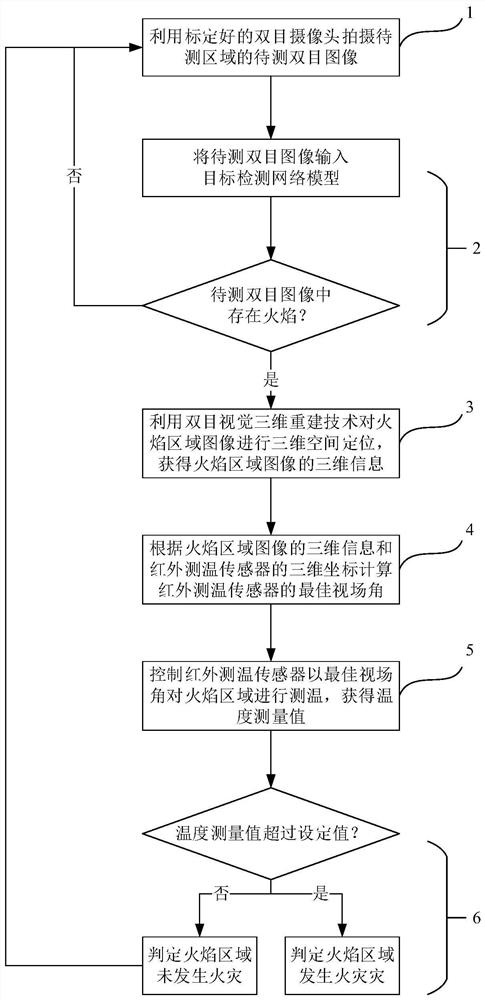Fire hazard identification method and system based on artificial intelligence and binocular vision
A technology of binocular vision and artificial intelligence, applied to fire alarms that rely on radiation, fire alarms, radiation pyrometry, etc., can solve the problem of easy misdetection of objects, low accuracy and reliability, and flame Problems such as low extraction accuracy can be achieved to reduce the possibility of fire misjudgment, improve accuracy, and reduce the layout scale
- Summary
- Abstract
- Description
- Claims
- Application Information
AI Technical Summary
Problems solved by technology
Method used
Image
Examples
Embodiment 1
[0046] A fire recognition method based on artificial intelligence and binocular vision, which is used for fire monitoring in the area to be tested. A binocular camera and an infrared temperature sensor probe are installed near the area to be tested, such as figure 1 , methods include:
[0047] 1) Use the calibrated binocular camera to shoot the binocular image of the area to be tested;
[0048] 2) Use the target detection network model to judge whether there is a flame in the binocular image to be tested, if so, output the flame area image in the binocular image to be tested, otherwise perform step 1);
[0049] 3) Use the binocular vision 3D reconstruction technology to perform 3D space positioning on the image of the flame area, and obtain the 3D information of the image of the flame area;
[0050] 4) Calculate the optimal field angle of the infrared temperature sensor according to the three-dimensional information of the flame area image and the three-dimensional coordinate...
Embodiment 2
[0067] A fire recognition system based on artificial intelligence and binocular vision, including a binocular camera module, an image detection module, a pose adjustment module, an infrared temperature measurement module and a fire recognition module;
[0068] The binocular camera module is used to use the calibrated binocular camera to shoot the binocular image of the area to be tested;
[0069] The image detection module is used to segment the flame area image from the binocular image to be tested by using the target detection network model;
[0070] The pose adjustment module includes a three-dimensional reconstruction unit and a pose calculation unit. The three-dimensional reconstruction unit uses the binocular vision three-dimensional reconstruction technology to perform three-dimensional space positioning on the image of the flame area to obtain the three-dimensional information of the image of the flame area. Three-dimensional information and three-dimensional coordinat...
PUM
 Login to View More
Login to View More Abstract
Description
Claims
Application Information
 Login to View More
Login to View More - Generate Ideas
- Intellectual Property
- Life Sciences
- Materials
- Tech Scout
- Unparalleled Data Quality
- Higher Quality Content
- 60% Fewer Hallucinations
Browse by: Latest US Patents, China's latest patents, Technical Efficacy Thesaurus, Application Domain, Technology Topic, Popular Technical Reports.
© 2025 PatSnap. All rights reserved.Legal|Privacy policy|Modern Slavery Act Transparency Statement|Sitemap|About US| Contact US: help@patsnap.com



